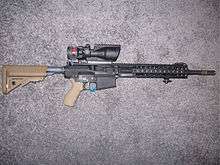Lewis Machine and Tool Company
 | |
| Private | |
| Industry | Defense |
| Founded | 1980 |
| Headquarters | Milan, Illinois, United States |
| Products | Firearms, weapons |
Number of employees | 100-150 |
| Website | www.LMTDefense.com |
Lewis Machine & Tool Company (LMT)[1] was founded by Karl Lewis in 1980. LMT started its business by providing law enforcement and government agencies with military type weapons and accessories. Today, LMT still provides law enforcement and government agencies with weapons, but they have now also expanded their services to foreign military and commercial retailers. All of LMT's engineering and manufacturing is done in house at the Milan, IL facility. LMT manufactures complete weapon systems such as the M4/AR-15 and the M203 grenade launcher.[2] Today, the Ministry of Defence of both the United Kingdom and New Zealand plus the US military utilize many of the products that LMT produces.
Products
LM308MWS and CQB16 MRP Defender
LMT created the Monolithic Rail Platform (MRP).[3] The MRP is a one piece upper receiver for the AR-15/M4/M16 platform and is made from a single aluminum forging. The LMT MRP has a quad rail system that utilizes the Mil-Std 1913 rail. It is available in two different lengths, one standard rifle length and the other for Close Quarters Battle (CQB). The MRP upper receiver has a quick change barrel system that allows the operator to change the caliber or the barrel length of the weapon in a very short period of time (≈ 1 minute).[4] The MRP also features a free-floating barrel, relatively low temperature to handguard & optics, long barrel life, easy-to-access/clean design, a straight gas tube resists bending and retains better alignment with gas key as compared to other designs, and a relatively low number of parts (13). Also, its top rail position matches M4 & E3-type weapons ensuring optics and sight compatibility and accepts standard & enhanced M16-type (Stoner design) components
In late 2009, LMT introduced the .308 Modular Weapon System LM308MWS.[5] The LM308MWS uses the 7.62×51mm NATO round. The LM308MWS is based on the proven Stoner Rifle design with some new features including the MRP upper receiver. An effective range of 800m and Sub-MOA grouping have been reported.
LMT is currently supplying 16", 18" and 20" 1:11¼" twist (rifling grooves complete one full revolution inside the bore every 11.25 inches) blackened stainless match barrels, as well as 16" and 20" chrome-lined chrome-moly 1:10" twist barrels for the civilian market.
L129A1
| L129A1 | |
|---|---|
 | |
| Type | Service rifle |
| Place of origin | United States of America |
| Service history | |
| In service | 2010-Present |
| Used by | New Zealand Army |
| Wars | Afghanistan |
| Production history | |
| Manufacturer | Lewis Machine & Tool |
| Specifications | |
| Weight | 9.8 pounds (4.4 kg) |
|
| |
| Cartridge | 7.62×51mm NATO |
| Barrels | 16 inches (410 mm) |
| Effective firing range | 800 m |
| Maximum firing range | 900 m |
| Sights | TA648-308 6×48 ACOG |
In 2009, Lewis Machine & Tool Co was contracted to supply the British Ministry of Defence (MOD) with 440 LM308MWS 7.62×51mm rifles[6] under the official service designation as the L129A1.[7] As of December 2014, over 3,000 units have been supplied to UK forces.[8]
The LM308MWS was then submitted for the British MOD's Urgent Operational Requirement (UOR) for immediate deployment of a semiautomatic 7.62 NATO caliber sharpshooter rifle in Afghanistan. Examples of other rifles submitted included the FN Herstal SCAR-H, Heckler & Koch HK417, and Sabre Defence XR-10 among others. LMT's rifle was chosen, earning it the L129A1 designation and entered service April 2010 in Afghanistan.[9]
Greg Felton of Law Enforcement International of UK explained: “The ammunition criteria stated by the MOD was that the rifle was to be able to use both RG 155-grain sniper ammunition, plus M80 ball and tracer, including de-linked machine gun belts. In the end during their trials with the various competitors, they found that the 155-grain fired so much better than the standard ball that it was made the official issue ammunition for the weapon. As to what it is “matched to,” we (Karl & I) designed the rifle to use both standard ball and 168-grain Match. With a 1:11.25 inch twist it works well with these weights, however, the heavier 175-grain projectiles need a faster twist for best results at longer ranges.”[9]
The primary optic chosen by the British for the L129A1 is a Trijicon ACOG TA648-RMR-UKS (NSN: 1005-99-305-9104).[9] The ACOG’s body is made of 7075 T6 aircraft aluminum, the same as the rifle’s receiver. A fiber-optic powers the reticle during daylight hours and a tritium light source in low or no light conditions. The aiming chevron’s brightness is adjustable by the user. The unit’s reticle has a built-in bullet drop compensator for 7.62×51mm NATO from 100 to 1,200 meters. To transition from long range to close-quarter battle, there is a Picatinny rail on the ACOG’s top that accepts a 1.2-ounce Trijicon 1× LED Rugged Miniature Reflex sight with a red dot powered by a CR2032 battery. Additional accessories include the optional L17A2 Schmidt & Bender 3-12 × 50 Sniper Scope, the OTIS 7.62 mm Sniper Cleaning System, a small Dewey rod to clean the chamber, a front sight adjustment tool and a rail-mounted, quick-detachable sling mount so the sling may be mounted anywhere on the rail.
The LM308MWS standard US commercial model differs slightly from the UK issued L129A1 in the following aspects:
- 1) the barrel is a 16" fully chrome-lined, cryogenically treated, polygonal rifled 1:10 right-hand twist chrome-moly machinegun grade steel, instead of the 16", 1:11¼" twist matte-black stainless steel barrel on the L129A1. It is crowned with LMT's special crown design, designed for maximum accuracy with ordinary ball ammunition.
- 2) the muzzle device is a standard M16A2 type flash suppressor instead of the SureFire suppressor mount.
- 3) the sights are the LMT detachable fixed sights instead of the Knight's Armament Company's low-profile folding micro back-up iron 200-600 rear sight and folding front sight.
- 4) the supplied furniture—LMT SOPMOD stock, Ergo suregrip, rail covers from Tango Down—is black instead of the tan/coyote brown supplied to the UK MoD.
- 5) the receiver is marked "LM308MWS", instead of "L129A1."
There is also a UK commercial variant of the L129A1. Designated the LMT308SP, the model is a straight pull action rifle, and not a semi-auto.[10]
The New Zealand Army adopted the rifle in October 2011. It differs from its UK counterpart in the use of a Leupold adjustable 4.5-14x scope, canted iron sights and a foldable foregrip.
CQB16/MARS-L
| CQB16/MARS-L | |
|---|---|
 | |
| Type | Service rifle |
| Place of origin | United States of America |
| Service history | |
| In service | 2015-Present |
| Used by | Royal New Zealand Navy, New Zealand Army, Royal New Zealand Air Force |
| Production history | |
| Manufacturer | Lewis Machine & Tool |
| Specifications | |
| Cartridge | 5.56×45mm NATO |
On 12 August 2015, the New Zealand Ministry of Defence announced that it would be replacing the current Steyr AUG 5.56×45mm rifle for all branches of the New Zealand Defence Force with a product from LMT,[11] later revealed to be their CQB16 version of the AR-15. A tender was released from May to November 2014. LMT was one of eight companies that submitted rifles for trials that took place between March and June 2015. Two versions with 406 mm (16.0 in) and 457 mm (18.0 in) barrels will be delivered firing heavy 77 gr (5.0 g) ammunition. Interestingly, selection of the CQB16 switches from fielding of a bullpup rifle to one with a traditional layout, as well as choosing a direct gas impingement operating system over a gas-piston system likely offered by competing entrants. The contract is for just over 9000 rifles to equip all three branches of the New Zealand Defence Force and be in service by 2016. The rifle is recognised by the Defence Force as the MARS-L (Modular Assault Rifle System-Light) [12][13]
References
- ↑ "Lewis Machine & Tool Company". Retrieved 25 December 2014.
- ↑ The National-Military Muscle on Display
- ↑ "Lewis Machine & Tool Monolithic Rail Platform". Retrieved 25 December 2014.
- ↑ LMT’s MRP 6.8 Battle Rifle
- ↑ "Multi-Mission LMT .308 MWS". Tactical Life. Retrieved 25 December 2014.
- ↑ "Global Defence News and Defence Headlines - IHS Jane's 360". Retrieved 25 December 2014.
- ↑ "L129A1 sharpshooter rifle". Retrieved 25 December 2014.
- ↑ "LMT .308 AR Review". Guns & Ammo. Retrieved 25 December 2014.
- 1 2 3 Sharpshooter: The UK’s New L129A1 7.62x51mm Rifle - SAdefensejournal.com, 11 January 2012
- ↑ "Lewis Machine & Tool Company, Inc. LM308SP-SS20 .308 Rifles". Retrieved 29 December 2015.
- ↑ "Individual Weapon Replacement". defence.govt.nz. Retrieved 25 April 2016.
- ↑ New Zealand Army Selects LMT To Replace Steyr AUG - Thefirearmblog.com, 18 August 2015
- ↑ Confirmed, LMT to supply NZDF with CQB16 - Thefirearmblog.com, 28 August 2015
External links
| Wikimedia Commons has media related to L129A1. |